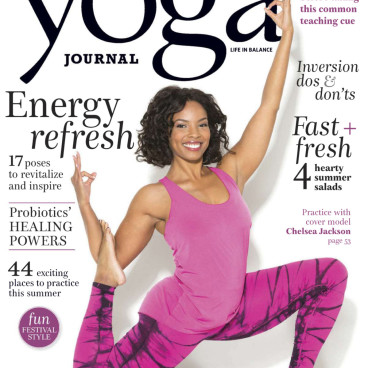I needed the words of this weeks’ Yogi in the Community Camille Bethune-Brown more than I think she knows. Camille talks with us this week about personal physical challenges and issues surrounding race, power, and yoga. In alignment with conversations during the Practice of Leadership Panel at the most recent Yoga Journal Conference , Camille shares her lived experiences as a Black yoga teacher who teaches a diverse range of students. If you are interested in change, transparency, and yoga-realness….This one is for you!
Name: Camille Bethune-Brown
Location: Baltimore, MD

What led you to the practice of yoga? Throughout my childhood I was always drawn to holistic lifestyle but didn’t truly understand how beautiful it was. It wasn’t until after I was diagnosed with spina bifida, tethered cord syndrome, and scoliosis that I decided to make conscious holistic changes. After the discovery I went to physical therapy frequently, only to have the pain come back shortly after her sessions. I was told that I may always the back pains and will have to visit a physical therapist for the rest of her life as well as be forced to wear an uncomfortable back brace for years to come. I experienced yoga years before and loved how I felt, relaxed and recharged but after the discovery of scoliosis I understood its power. I began practicing yoga every day and found that the back and neck spasms completely went away. I would say that the authentic purpose of my yoga is simply to become more authentic – to expand into possibility and break down the boundaries that enclose me within what is known and what is safe. My practice allows me to evolve into not only who I feel I am meant to be as an individual, but who I feel I am meant to be as part of the human collective. As I work through my practice daily, I am uniquely reminded of how connected we all are.
What has been the most challenging part of your yoga journey?

As a yoga teacher of color, race is one of those issues that is very prevalent and no one talks about it. I try to take race, color, religion, and beliefs out of something I love so much. However that just might be impossible. I teach about 7 classes a week, and in every class there are usually no black faces. As a yoga instructor of color leading an all white class can provide some challenges depending on the area. I’ve had students tell me that they didn’t know minorities practice yoga let alone teach. I’ve had instances where some white clients don’t necessarily like the idea of someone who is black telling them what to do. These experiences allowed me to grow as an instructor and it led me to wonder why there isn’t enough diversity in yoga.
I have a few hypotheses about this lack of diversity. . One guess is that yoga is usually quite expensive (as much as $20+ per class in DC/MD), so this disproportionately excludes certain minorities, some who are substantially more likely to be in a lower income bracket. Also, yoga is heavily marketed towards white women, but not towards other consumer groups (when was the last time you saw a yoga-themed ad on BET?), so it might be that Americans of various minority groups may not be drawn to yoga because they are, in essence, not being invited to it.
My goal is to inspire and show that we yoga teachers and practitioners come in many shapes, color, creeds. Yoga in order to become more inclusive needs to become culturally sensitive, compassionately inclusive, and humble and corporately responsible.
How has yoga taught you about strength and endurance? Not just on the mat, but in life?

“A spiritual warrior’s life is an endless challenge, and challenges cannot possibly be good or bad. The basic difference between and ordinary person and a warrior is that a warrior takes everything as a challenge, while an ordinary person takes everything as a blessing or a curse.”
Emotions are a fact of life. The trick is to see that they pass through us and move away; the trick is not to get stuck thinking that we are an emotion – we might be feeling something pretty strongly (fear, shame, anger), but it does not define us. Life is choppy and it doesn’t always make sense; yoga helps us to learn to ride the waves rather than drowning in them. In the end, what we learn from strong emotions (if we are prepared to let them teach us) are some of the most important lessons of our lives. In the end, when we let go, surrender to the journey and refuse to either reject or embrace strong emotions, we emerge stronger, kinder and more understanding – both of ourselves and others.
What advice would you give folks who are just beginning their yoga practice?
Pay attention to the breath and enjoy the journey. . Go with no expectations, stay with an open mind and leave with gratitude for the opportunity.


What a wonderful person and a great role model. I’ve had white, brown and black yoga teachers and loved and respected all of them. I have a lot of Friends on Facebook that are black and practice yoga including Koya Webb and Tiffany Janay who are both very important to me and I love so much and have learned so much from. I also always wanted to attend the amazing yoga classes in New York led by Zen Holmes which mixes live music of didgeridoo and African drums. Ely Pozos, of Mexican heritage and born in Guadalajara, has a studio in Las Vegas and she has become a light for me as well. If I lived in Baltimore I would attend Camille’s classes because she’s really focused and super intelligent as well.